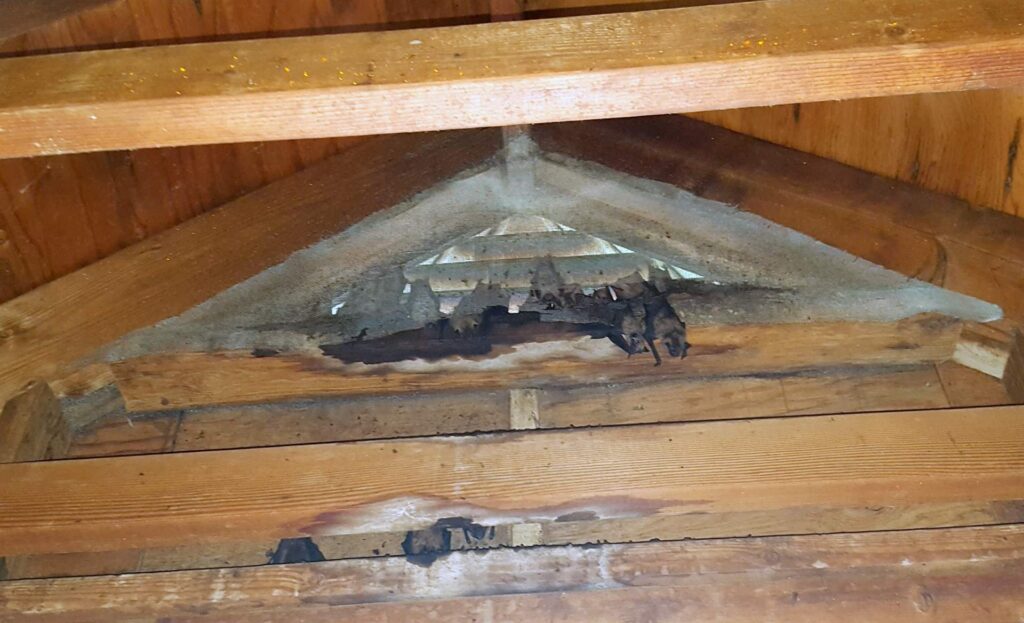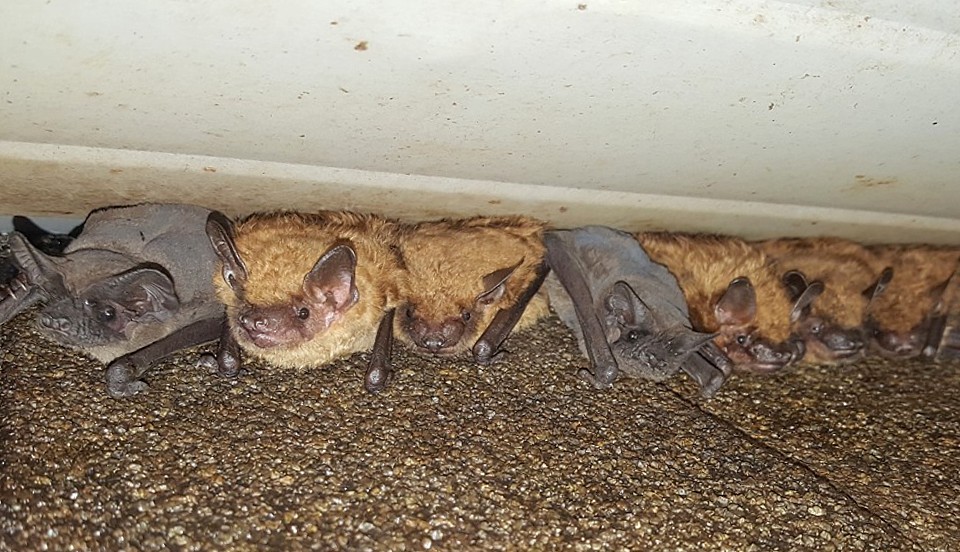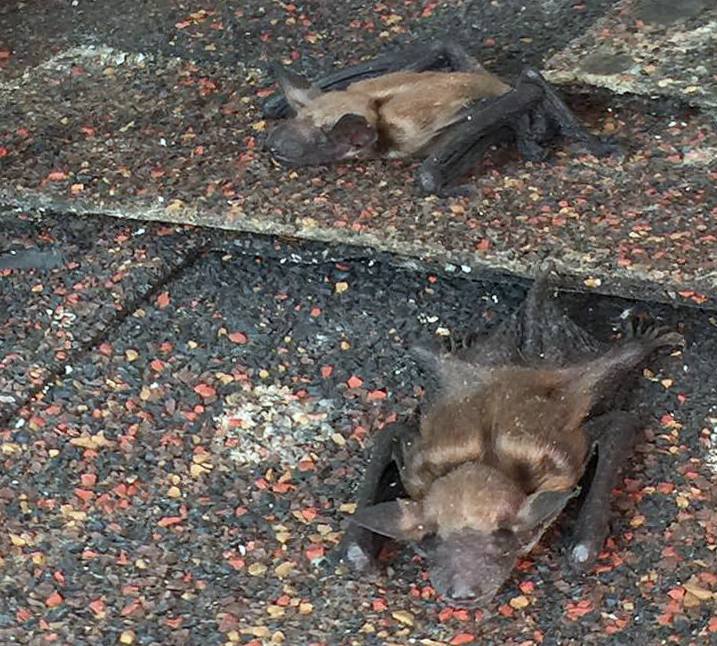Bat Removal

Bats are a very important, yet very hated nuisance animal in American society. They are dangerous to have around homes and properties, but they are also vital to ecosystems. Getting a bat or multiple bats in your home can be a less-than-fun experience, however, it is not the end of the world. Continue reading to learn more about bats and how you can get rid of them for good.

What problems do bats cause?
When bats make their way into your home or onto your property, it is important to realize how many diseases they can and do spread. There have been many studies performed which show bats can carry over 130 different diseases, each of them potentially being harmful to humans or pets. Diseases like rabies, Marburg, Ebola, a variety of coronaviruses, and many, many more are commonly carried by bats around the world. In addition to these problems, they also can contaminate various surfaces simply by touching them, as they often leave behind parasitic critters like bat bugs. Bats spread diseases through direct bites and scratches, leaving their feces in virtually every part of your home, and even by getting their saliva on various surfaces. Each one of these transmission methods could affect you and your whole family in potentially deadly ways.
As if the potential for serious health issues was not enough, bats also are very destructive animals to have in your home. It might seem odd, but it actually comes down to their feces, or guano, as it is commonly called. Virtually every time a bat gets into a home, it will try to get into the attic. Once in the attic, bats leave their guano virtually everywhere, as they hang upside down in their roosts. These droppings begin to coat the insulation in your home, and this can severely hinder your insulation’s insulative abilities. This might not seem like a huge deal, but in the long run, decreased insulation efficiency can lead to large energy expenses in the long run. This destructive problem and their ability to spread disease are excellent reasons to get bats out as soon as possible.
How can I prevent bats?
Bats can be a real headache when you are trying to prevent them from coming into your home. It is pretty much impossible to prevent bats from coming onto your property, as they fly everywhere, capturing thousands of insects a night. To keep these winged creatures from coming into your home, you will need to follow a sealing-up process. Especially with bats, it is very important that you check your home’s exterior, looking for any problem areas like holes, gaps, or cracks. Bats are able to get into very small places with ease. Pay special attention to the roof-line of your home, checking the soffit, fascia, shingles, and all around the attic. If you find any problem areas, be sure to seal them with some kind of all-weather sealant or some aluminum sheeting. Once the exterior is done, be sure to perform the same process for the interior of your home. Once this is done, it is highly unlikely that any bat will be able to find its way into your home.
How do I remove bats?
Removing bats can be a very intense ordeal, as many homeowners try to remove them on their own in a variety of different ways. While this might seem simple enough, there are several factors at play that should be heavily considered. First, and most importantly, in many states, bats are a protected species and it can even be illegal to remove them in some cases. Second, if a bat is exposed to any kind of stress, there is a better than ever chance that it will not survive for very long, as stress causes them many health problems that they may not be able to recover from. Third, bats are incredibly important to virtually every ecosystem, as they eat insects that are not good to have around. For instance, many bats can eat over 100 mosquitoes an hour, helping to keep you and your family safe from any mosquito bites. Finally, trying to deal with bats on your own is very dangerous, as the diseases that bats can carry are not a joking matter and can potentially cause death to humans and pets.
Why hire New Jersey Wildlife & Pest Control?
Here at New Jersey Wildlife & Pest Control, we use our patented tunnel technology to get bats out of your home with no harm or stress to bats, and no danger to you. Many other pest control companies will keep away from bat problems, as they can be very ineffective, especially when using hand-made tunnels, as these rarely work with bats. Since bats are endangered in New Jersey, hiring the professionals at New Jersey Wildlife & Pest Control is your best choice for getting bats out of your home safely, effectively, and humanely. Our patented system works so well that bats should be gone within 48 hours, and we even use a CCTV monitor to know exactly when your bats have left. If you are dealing with a bat problem that you want to be fixed, be sure to call us here at New Jersey Wildlife & Pest Control.

How to Remove Bats From The Wall
Bats are small nocturnal animals that prefer to stay hidden and away from humans. However, these animals are always in search of the perfect roost in proximity to an abundance of food and water. If bats happen to find their way into your home in their quest for an ideal roosting place, then you might be in big trouble. To learn more about keeping bats out of the wall visit pestwildlife.com.
Despite their quiet and discreet lifestyle, bats bring with them destructive and disease-laden guano. When bats enter a building, they don’t usually target the walls. They mostly enter through cracks on the roof or attic and eventually find their way into the walls.
If bats are roosting in your property and have found their way into your walls, here’s how you can tell that you may have a bat problem:
- If you see bats flying around outside your home, or you see them hanging around your property every night. Chances are, they live somewhere in your home and come out every night to feed.
- If you hear squeaking and flapping sounds coming from the inside of your walls, especially at night.
- If you see tracks of bat dropping (called guano) outside your home or at certain areas of your house.
How To Remove Bats From A Wall
Step 1: Identify the entry points: the very step towards evicting these small winged mammals from your walls is to locate any small cracks and crevices on the wall that acts as their entry and entrance point(s). Bats are very tiny animals, usually between 2 and 4 inches in length, therefore they are able to squeeze through very small holes. When trying to identify the entry point of bats, look for areas with greasy stains, as this is evidence of bats passing going in and out.
Step 2: Seal off the holes: If you are able to find more than a couple of cracks that allow bats to enter your walls, then the next step is to diligently seal off all the holes. Seal all the cracks (except for one), with a good sealant. Leaving one exit point open will allow the bats to safely exit from the walls. If you seal off all the holes, the bats will starve to death or suffocate within your walls, and the smell of decomposing flesh will cause an awful stench in your house.
Step 3: Install a one-way exit door: to ensure that the bats exit your walls and never return, it’s important that you install a one-way exclusion device. A one-way exit door or exclusion device will allow the bats to leave safely and when they are out, they will be unable to find their way back in. Once you are certain that all the bats are out of your wall. Proceed to remove the exclusion device and completely seal off the last hole.
Pro Tips: Excluding bats from your wall may sound really simple, but in reality, it’s a very tricky procedure and can be quite tasking. When trying to exclude bats, you have to remember that they are nocturnal animals and will only fly out at night to feed.
Therefore, you will have to monitor their movement at night to ensure that you see where they fly out from and how they get back. Doing this will help you get rid of them faster, without doing a botched job. Bats will usually leave at dusk and come back just before dawn.
Get Professional Help!
Animal exclusion is a dicey business, especially if you have no experience in handling nuisance wildlife. Bats may be small, but they will bite humans in self-defense, just like many other animals do.
We do not recommend DIY bat exclusions because bats act as hosts to a number of deadly viruses, including the Rabies virus, and bat guano carries an airborne fungus that causes Histoplasmosis, which is a respiratory disease that can be fatal. For your own safety and that of your family, get professional help.
At New Jersey Wildlife & Pest Control, our team of experts is well-versed in bat exclusions and clean-up. With experience gained from years of fieldwork, we will make sure that bats never trouble you again.

How to Trap a Bat?
One of the most common flying intruders, bats, are a common problem across United States households and the world. There’s a lot that these little guys are willing to do to get shelter, and they often bring dozens of friends along with them. However, this has led to a bad stigma, with many people resorting to violence against bats in retaliation.
While bats don’t deserve a lot of the hate they get, the danger and damage they can cause on a property more than makes for enough reason to trap and remove one. Nonetheless, it can be dangerous and even illegal to do so in some local jurisdictions. So, here’s how to trap a bat.
Check Your Local Laws
The very first thing to do is check local regulations — bats are often protected under local laws, meaning that you can’t even touch them without potentially being fined or arrested. That means that it’s crucial to check in advance to determine whether or not you’re putting yourself at risk legally and literally.
While it’s less common to find unprotected bats in much of the continental United States, a shining example of a trap-friendly section would be the Southeastern states. Only a few species are protected, and it’s frequently only against killing them.
Still, it’s vital to check things out before trapping since you won’t even be able to do much with the bat without animal control’s assistance or a local company like New Journey Pest Control. Unfortunately, only a few have the knowledge and ability to prevent bats from returning just days later. These same people follow protection laws, meaning you need to know in advance.
Finding the Bats
However, if you live in an area where bats aren’t entirely protected, then you’re free to trap them. First, though, you’ll need to find them, as bats are incredibly tricky to capture.
The best thing to do is investigate the area, checking for the number of bats and entrances/exits available either while the bats are asleep or gone from your property. As such, the best times to check are the middle of the day or some time at night once nocturnal creatures leave.
We recommend if you look for the bats (i.e., not call animal control or a control company for help), to go when you’re confident you’ll be safe, in protective gear and safety equipment. While bats might not seem dangerous, they’re more than ready and capable of seriously injuring you.
Trapping
Once you’ve found the bats, though, seal all but one entrance or exit to their habitat. This will force the animals to eventually come out of only one pathway, which you can use to trap them.
After this finishes, you have two primary options: set up netting on the last entrance to let control come by later and remove the bats or set up an animal cage trap with small enough slits to prevent the bats from escaping.
Netting works as a temporary solution, letting you use enough time to contact the professionals and remove the animals for you. In addition, the most mesh is capable of trapping bats in an area, helping stall for help. As for cage traps, they’re a much more immediate solution, although only if the cage is small enough to prevent a bat from escaping.
However, traps and netting are only temporary, as relocating bats won’t do much. On top of having a great sense of echolocation, bats also have a fantastic directional sense, allowing them to return to a home more than 500 miles away. So, unless you’re planning on driving more than 500 miles away to drop off bats, it’s best to trap them before letting the pros take it from there.
